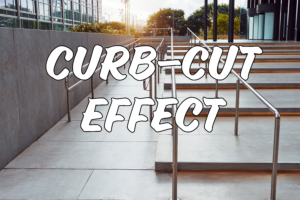In the late 1960s, a small yet significant change took place on the streets of Berkeley, California, that would ripple across society in ways few could have predicted. This change, the introduction of curb cuts—small ramps connecting sidewalks to the street—was initially implemented to assist people using wheelchairs. However, it quickly became evident that these ramps were beneficial to a much broader audience, including parents with strollers, workers pushing carts, and even runners and cyclists. This phenomenon, where a solution designed to aid a specific group ends up benefiting a much larger population, is known as the “curb-cut effect.”
The curb-cut effect has since become a powerful metaphor for the broader impact of accessibility in various sectors, particularly in business and the arts. By prioritizing inclusivity, organizations not only meet the needs of marginalized groups but also enhance the experience for everyone involved.
Accessibility in Business: A Competitive Advantage
In the business world, accessibility is often viewed through the lens of compliance—something that must be done to meet legal standards and avoid penalties. However, forward-thinking companies have begun to recognize that accessibility is not just a regulatory requirement but a strategic advantage.
For example, consider the impact of digital accessibility. Websites and applications that are designed to be accessible to people with disabilities—through features like screen reader compatibility, keyboard navigation, and alternative text for images—are also more user-friendly for the general population. An accessible website is easier to navigate, loads faster, and provides a better overall user experience. This, in turn, can lead to higher customer satisfaction, increased sales, and greater brand loyalty.
Moreover, businesses that prioritize accessibility often find themselves at the forefront of innovation. By focusing on the needs of users with disabilities, companies can uncover new opportunities for product development and service delivery that might otherwise go unnoticed. For instance, the voice-activated technology initially developed to assist people with mobility impairments has now become a mainstream feature in smartphones, smart homes, and other devices.
Inclusivity in the workplace is another area where the curb-cut effect is evident. Companies that embrace diversity, including hiring people with disabilities, often experience improved employee morale, increased creativity, and a broader range of perspectives. This diversity of thought can lead to more innovative solutions and a stronger, more adaptable organization.
The Arts: Accessibility as a Catalyst for Creativity
The arts have always been a powerful medium for social change, and accessibility within the arts is no exception. By making the arts more accessible to people with disabilities, artists and organizations can create richer, more diverse experiences that resonate with a wider audience.
One way this is being achieved is through the incorporation of universal design principles in theaters, museums, and galleries. For example, providing sign language interpretation, audio descriptions, and tactile exhibits not only makes the arts accessible to people with hearing or visual impairments but also enhances the experience for all attendees. When everyone can engage with the artwork or performance in a way that suits their needs, the arts become a more inclusive and enriching experience.
Furthermore, accessibility in the arts often leads to the creation of new forms of expression. Artists with disabilities, who may approach their craft from a different perspective, bring unique voices and experiences to the forefront. This diversity enriches the artistic landscape, challenging traditional notions of art and expanding the possibilities of what art can be.
The Broader Impact: Building Inclusive Communities
The curb-cut effect in business and the arts ultimately contributes to building more inclusive communities. When accessibility is prioritized, it sends a message that everyone belongs and that all contributions are valued. This not only benefits individuals with disabilities but also fosters a sense of belonging and community for everyone.
In addition, accessible businesses and arts organizations are more likely to attract a diverse audience, leading to greater cultural exchange and understanding. As people from different backgrounds and abilities come together, they can learn from one another and build a more inclusive society.
Embracing the Curb-Cut Effect
The curb-cut effect serves as a powerful reminder that when we design for accessibility, we create a better experience for all. In both business and the arts, prioritizing accessibility not only meets the needs of marginalized groups but also drives innovation, creativity, and community building. By embracing the principles of inclusivity and accessibility, we can create a world where everyone has the opportunity to participate, contribute, and thrive.
In an increasingly interconnected and diverse world, the curb-cut effect is not just a social good—it is a vital component of success in business and the arts. As more organizations recognize the value of accessibility, we can look forward to a future where the benefits of inclusivity are shared by all.

